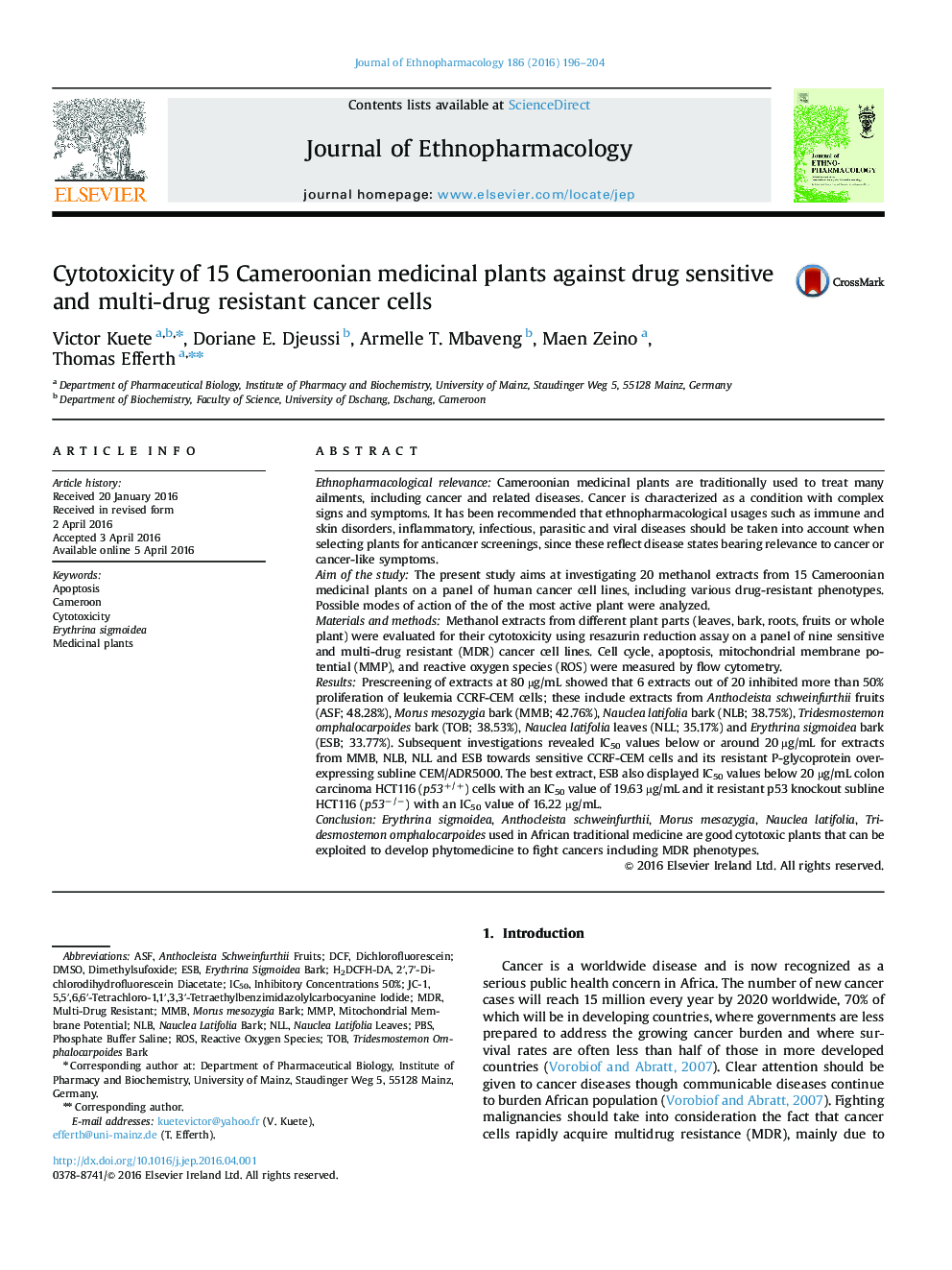| کد مقاله | کد نشریه | سال انتشار | مقاله انگلیسی | نسخه تمام متن |
|---|---|---|---|---|
| 2544713 | 1560376 | 2016 | 9 صفحه PDF | دانلود رایگان |
Ethnopharmacological relevanceCameroonian medicinal plants are traditionally used to treat many ailments, including cancer and related diseases. Cancer is characterized as a condition with complex signs and symptoms. It has been recommended that ethnopharmacological usages such as immune and skin disorders, inflammatory, infectious, parasitic and viral diseases should be taken into account when selecting plants for anticancer screenings, since these reflect disease states bearing relevance to cancer or cancer-like symptoms.Aim of the studyThe present study aims at investigating 20 methanol extracts from 15 Cameroonian medicinal plants on a panel of human cancer cell lines, including various drug-resistant phenotypes. Possible modes of action of the of the most active plant were analyzed.Materials and methodsMethanol extracts from different plant parts (leaves, bark, roots, fruits or whole plant) were evaluated for their cytotoxicity using resazurin reduction assay on a panel of nine sensitive and multi-drug resistant (MDR) cancer cell lines. Cell cycle, apoptosis, mitochondrial membrane potential (MMP), and reactive oxygen species (ROS) were measured by flow cytometry.ResultsPrescreening of extracts at 80 µg/mL showed that 6 extracts out of 20 inhibited more than 50% proliferation of leukemia CCRF-CEM cells; these include extracts from Anthocleista schweinfurthii fruits (ASF; 48.28%), Morus mesozygia bark (MMB; 42.76%), Nauclea latifolia bark (NLB; 38.75%), Tridesmostemon omphalocarpoides bark (TOB; 38.53%), Nauclea latifolia leaves (NLL; 35.17%) and Erythrina sigmoidea bark (ESB; 33.77%). Subsequent investigations revealed IC50 values below or around 20 µg/mL for extracts from MMB, NLB, NLL and ESB towards sensitive CCRF-CEM cells and its resistant P-glycoprotein over-expressing subline CEM/ADR5000. The best extract, ESB also displayed IC50 values below 20 µg/mL colon carcinoma HCT116 (p53+/+) cells with an IC50 value of 19.63 µg/mL and it resistant p53 knockout subline HCT116 (p53−/−) with an IC50 value of 16.22 µg/mL.ConclusionErythrina sigmoidea, Anthocleista schweinfurthii, Morus mesozygia, Nauclea latifolia, Tridesmostemon omphalocarpoides used in African traditional medicine are good cytotoxic plants that can be exploited to develop phytomedicine to fight cancers including MDR phenotypes.
Cell cycle distribution of leukemia CCRF-CEM cells treated with bark extract of Erythrina sigmoidea (ESB) and doxorubicin, the two most active samples, at their IC50 values for 72 h: ESB as well as doxorubicin induces apoptosis and considerably altered the distribution of different phases, with time-dependent increase of sub-G0/G1 phase cells. Upon 72 h treatment, ESB induced cell cycle arrest in G0/G1.Figure optionsDownload high-quality image (145 K)Download as PowerPoint slide
Journal: Journal of Ethnopharmacology - Volume 186, 20 June 2016, Pages 196–204
